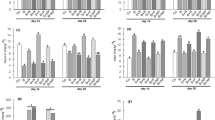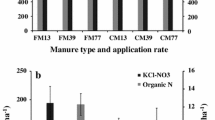Abstract
The immobilization and mineralization of N following plant residue incorporation were studied in a sandy loam soil using15N-labelled field pea (Pisum sativum L.) and spring barley (Hordeum vulgare L.) straw. Both crop residues caused a net immobilization of soil-derived inorganic N during the complete incubation period of 84 days. The maximum rate of N immobilization was found to 12 and 18 mg soil-derived N g−1 added C after incorporation of pea and barley residues, respectively. After 7 days of incubation, 21% of the pea and 17% of the barley residue N were assimilated by the soil microbial biomass. A comparison of the15N enrichments of the soil organic N and the newly formed biomass N pools indicated that either residue N may have been assimilated directly by the microbial biomass without entering the soil inorganic N pool or the biomass had a higher preference for mineralized ammonium than for soil-derived nitrate already present in the soil. In the barley residue treatment, the microbial biomass N was apparently stabilized to a higher degree than the biomass N in the pea residue treatment, which declined during the incubation period. This was probably due to N-deficiency delaying the decomposition of the barley residue. The net mineralization of residue-derived N was 2% in the barley and 22% in the pea residue treatment after 84 days of incubation. The results demonstrated that even if crop residues have a relative low C/N ratio (15), transient immobilization of soil N in the microbial biomass may contribute to improved conservation of soil N sources.
Similar content being viewed by others
References
Bremer E, Van Houtum W Van Kessel C (1991) Carbon dioxide ecolution from wheat and lentil residues as affected by grinding, added nitrogen, and the absence of soil. Biol Fertil Soils 11:221–227
Brookes PC, Landman A, Pruden G, Jenkinson DA (1985) Chloroform fumigation and the release of soil nitrogen: a rapid extraction method to measure microbial biomass nitrogen in soil. Soil Biol Biochem 17:837–842
Hadas A, Sofer M, Molina JAE, Clapp CE (1992) Assimilation of nitrogen by soil microbial population: NH4 versus inorganic N. Soil Biol Biochem 24:137–143
Jansson SL, Persson J (1982) Mineralization and immobilization of soil nitrogen. In: Stevenson FJ (ed) Nitrogen in agricultural soils. ASA Special Publication no 22, Madison, Wis, pp 229–252
Jansson SL, Hallem MJ, Batholomew WV (1955) The preferential utilization of ammonium over nitrate by microorganisms in the decomposition of oat straw. Soil Sci Soc Am Proc 17:330–334
Jenkinson DS (1981) The fate of plant and animal residues in soil. In: Greenland DJ, Hayes MHB (eds) The chemistry of soil processes. John Wiley and Sons, Chichester, pp 505–561
Jenkinson DS (1988) The determination of microbial biomass carbon and nitrogen in soil. In: Wilson JR (ed) Advances in nitrogen cycling in agricultural ecosystems. CAB International, Wallington, pp 368–386
Jensen ES (1991) Evaluation of automated analysis of15N and total N in plant material and soil. Plant and Soil 133:83–92
Jensen ES (1994a) Dynamics of mature pea residue nitrogen turnover in unplanted soil under field conditions. Soil Biol Biochem 26:455–464
Jensen ES (1994b) Mineralization-immobilization of nitrogen in soil amended with low C:N ratio plant residues with different particle size. Soil Biol Biochem 26:519–521
Jensen ES (1996) Compared cycling in a soil-plant system of pea and barley residue nitrogen. Plant and soil (in press)
Knapp EB, Elliott LF, Campbell GS (1983) Microbial respiration and growth during the decomposition of wheat straw. Soil Biol Biochem 15:319–323
Ladd JN, Forster RC (1988) Role of microflora in nitrogen turnover. In: Wilson JR (ed) Advances in nitrogen cycling in agricultural ecosystem. CAB International, Wallingford, pp 113–129
Marstorp H, Kirchmann H (1991) Carbon and nitrogen mineralization and crop uptake of nitrogen from six green manure legumes decomposing in soil. Acta Agric Scand 41:243–252
Mary B, Recous S, Darwis D, Robin D (1996) Interactions between decomposition of plant residues and nitrogen cycling in soil. Plant and Soil (in press)
McKenney DJ, Wang S-W, Drury CF, Findlay WI (1995) Denitrification, immobilization and mineralization in nitrate limited and nonlimited residue-amended soil. Soil Sci Soc Am J 59:118–124
Molina JAE, Clapp CE, Shaffer MJ, Chichester FW, Larson WE (1983) NCSOIL, a model of nitrogen and carbon transformations in soil: Description, calibration and behavior. Soil Sci Soc Am J 47:85–91
Ocio JA, Martinez J, Brookes PC (1991) Contribution of straw-derived N to total microbial biomass N following incorporation of cereal straw to soil. Soil Biol Biochem 23:655–659
Parr JF, Papendick RI (1978) Factors affecting the decomposition of crop residues by microorganisms. In: Oschwald WR (ed) Crop residue management systems. Publication no 31. American Society of Agronomy, Madison, Wis, pp 101–129
Paul EA, Clark FE (1989) Soil microbiology and biochemistry. Academic Press, San Diego, 273 pp
Powlson DS (1994) The soil microbial biomass: Before, beyond and back. In: Ritz K, Dighton J, Giller KE (eds) Beyond the biomass. John Wiley and Sons, Chichester, pp 3–20
Recous S, Robin D, Darwis D, Mary B (1995) Soil inorganic N availability: Effect on maize residue decomposition. Soil Biol Biochem 27:1529–1538
Reinertsen SA, Elliott LF, Cochran VL, Campbell GS (1984) Role of available carbon and nitrogen in determining the rate of wheat straw decomposition. Soil Biol Biochem 16:459–464
SAS (1990) SAS Procedures Guide. Version 6, 3rd ed. SAS Institute Inc, Cary, NC, 705 pp
Sørensen LH (1981) Carbon-nitrogen relationships during the humification of cellulose in soil containing different amounts of clay. Soil Biol Biochem 13:313–321
Thomsen IK (1993) Turnover of15N-straw and NH4NO3 in a sandy loam soil: Effects of straw disposal and N fertilization. Soil Biol Biochem 25:1561–1566
Van Soest PJ (1963) Use of detergents in the analysis of fibrous feeds. Il. A rapid method for the determination of fiber and lignin. J Assoc Anal Chem 46:829–835
Waksman SA, Tenney F (1928) Composition of natural organic materials and their decomposition in the soil: 111. The influence of nature of plant upon the rapidity of its decomposition. Soil Sci 26:155–171
Author information
Authors and Affiliations
Corresponding author
Rights and permissions
About this article
Cite this article
Jensen, E.S. Nitrogen immobilization and mineralization during initial decomposition of15N-labelled pea and barley residues. Biol Fert Soils 24, 39–44 (1997). https://doi.org/10.1007/BF01420218
Received:
Issue Date:
DOI: https://doi.org/10.1007/BF01420218




